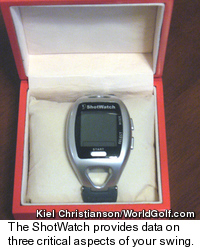 EQUIPMENT REVIEW
EQUIPMENT REVIEW
ShotWatch provides data, and some distraction, to your golf practice
By Kiel Christianson,
Senior Writer
The golf swing is a complex biomechanical process, requiring coordination, speed, flexibility, power and timing. A growing body of research on the psychology of golf strongly suggests, though, that the paradox of the golf swing is this: The more you focus on these individual aspects of the swing, the worse the swing becomes.
So, I am always skeptical when a new training aid comes along that promises to fix multiple problems all at the same time by focusing your attention on each one.
The new ShotWatch (MSRP $199) is one of these multi-faceted training aids. It is a wristwatch-like instrument designed to measure grip pressure, swing speed (well, hand speed) and swing tempo.
In my experience testing it, though, even when the ShotWatch works, it does as much to distract you from your swing as it does to inform you about it.
How the ShotWatch works
After reading the seemingly simply written instructions, I strapped on the sleek silver ShotWatch and waited for the double beep followed by a single beep telling me that the contraption was armed. On the screen, I saw readings for swing speed (arm speed, really), grip pressure and tempo, and proceeded to take dozens of swings, testing each one of these factors. The frustrating part, however, is that I did not quite know what any of the numbers meant.
I noticed in the box a small DVD of detailed operating instructions, along with a Web site (www.shotwatch.com) with an instructional video. Of course, I didn't have a computer or DVD player with me on the range, so these were useless.
|
In order to better understand just what it was the ShotWatch was telling me, I contacted Ted Caldwell, president of ShotWatch, who was kind enough to call me to walk me through operation of the device.
Several clarifications were required. First, with respect to grip pressure, I asked Caldwell what the reading I received (133) meant. Was it "pounds per square inch" or something?
"No," he explained. "We calibrated that measurement between how hard we could squeeze the club and how loose we could hold it." Apparently my reading was fairly relaxed. The problem, to my mind at least, is that the user gets some measurement but has no idea what it means. Without Caldwell on the phone, I wouldn't know whether 133 was too tight, too loose or just right.
Tempo presented a similar problem. My reading was 315. Huh?
"That is 3.15 seconds," explained the extremely patient Caldwell.
But again, I didn't know exactly when that time began or when it ended. And again, is that too fast? Too slow?
Finally, the hand speed presented a final mystery. I was swinging my driver without a ball while talking with Caldwell and as hard and fast as I possibly could. Yet the speed never broke 60 mph. From time spent on launch monitors, I know my clubhead speed is around 110mph when I really try to let it fly, with ball speed in the low 160s. So, um, what does this hand speed mean?
"That is somewhat odd," Caldwell answered. "I generally have a hand speed in the 70s, and I don't swing that hard."
The verdict on the ShotWatch
Despite Mr. Caldwell's patient, genial assistance, I had a very hard time indeed making heads or tails of the ShotWatch or the information it was giving me. Ideally, one would hit balls and with the watch's memory function, save the readings for the good shots, developing a profile of those shots. Then one would aim for that profile in successive practice sessions, developing muscle-memory.
The problem was, for me at least, that the ShotWatch became so completely distracting that I couldn't concentrate on anything but trying to operate it. And I didn't even try to coordinate the memory function with my good shots.
Part of the problem lay in the first model I was sent, which turned out to be faulty.
"This is the first-run production," explained Caldwell, "and there are a few small issues to work out in the second run."
The second model I received worked more consistently than the first, but the battery ran low very quickly, and then the odd measurements and occasionally balky performance I'd noted in the first model returned.
My advice for anyone using the ShotWatch for practice would be to focus on just one reading at a time, rather than all three. Trying to address all three aspects of the swing at one time might, according to recent research and my own gut feeling, hurt rather than help your swing.
For more information, visit www.shotwatch.com.
November 11, 2008
Any opinions expressed above are those of the writer and do not necessarily represent the views of the management.